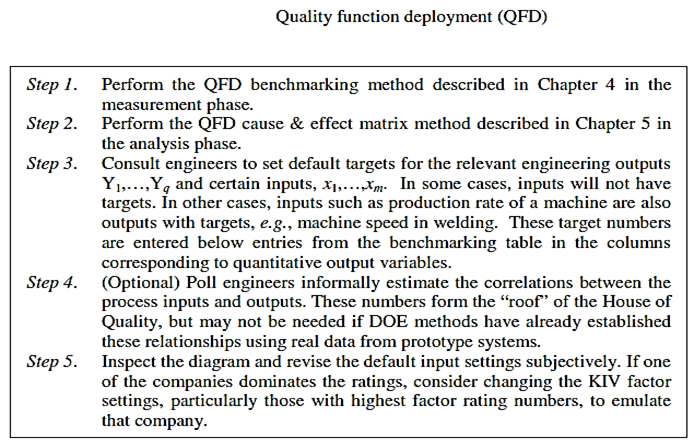Quality Function Development
Introduction:
The method “Quality Function Deployment” (QFD) is a popular formal approach to support what might be called moderately formal decision-making.
Quality Function Deployment (QFD):
QFD involves creating a full “House of Quality” (HOQ), which is a large matrix that contains much information relevant to decision-making.
This HOQ matrix constitutes an assemblage of the results of the benchmarking and cause & effect matrices methods together with additional information. Therefore, information is included both on what makes customers happy and on measurable quantities relevant to engineering and profit maximization. The version of QFD presented here is inspired by “enhanced QFD” in Clausing (1994 pp. 64-71).

Formal Optimization:
In some situations, people are comfortable with making sufficient assumptions such that their decision problems can be written out very precisely and solved with a computer. For example, suppose that a person desires to maximize the profit, G(x1), from running a system as a function of the initial investment, x1. Further, suppose one believes that the following relationship between profit and x1 holds
G (x1) = –11 12x1 – 2x1 2and
That one can only control x1 over the range from x1 = 2 to x1 = 5. Functional relationships like g(x1) = –11 12x1 – 2x1 2 can be produced from regression modeling potentially derived from applying design of experiments.
The phrase “optimization solver” refers to the approach the computer uses to derive recommended settings. In the investment example, it is possible to apply the Excel spreadsheet solver with default settings to derive the recommended initial investment. This problem can be written formally as the following “optimization program” which constitutes a precise way to record the relevant problem:
Maximize: g(x1) = –11 12x1 – 2x1 2
Subject to: x1∈[2, 5] Where x1 ∈[2, 5] is called a “constraint” because it limits the possibilities for x1. It can also be written
2 ≤ x1≤ 5.
The term “optimization formulation” is synonymous with optimization program. The term “formulating” refers to the process of transforming a word problem into a specific optimization program that a computer could solve. The study of “operations research” focuses on the formulation and solutions of optimization programs to tune systems for more desirable results. This is the study of perhaps the most formalized decision processes possible.